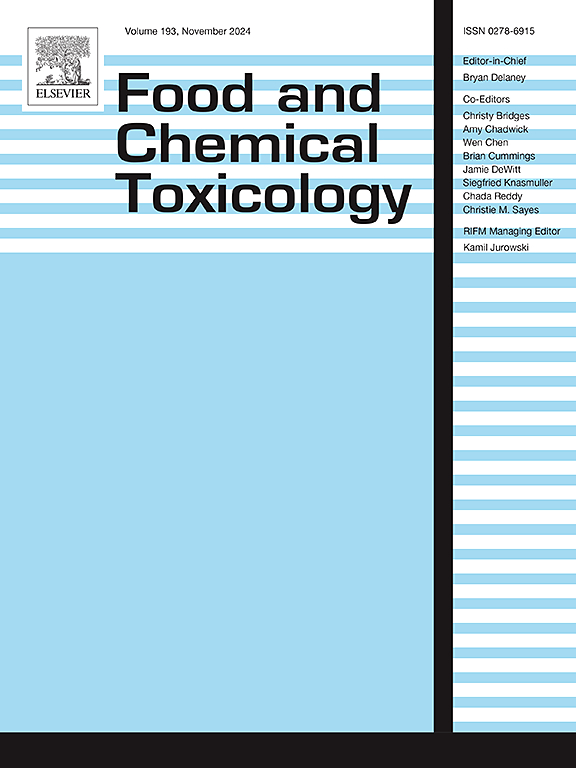Assessing nanotoxicity of food-relevant particles: A comparative analysis of cellular responses in cell monolayers versus 3D gut epithelial cultures
IF 3.9
3区 医学
Q2 FOOD SCIENCE & TECHNOLOGY
引用次数: 0
Abstract
Engineered nanoparticles (NPs) are extensively used in the food industry, yet safety concerns remain. The lack of validated methodologies is a bottleneck towards resolving this uncertainty. Hence, the current study aims to compare two cell models by examining the toxicological impacts of two food-relevant NPs (SiO2 and Ag) on intestinal epithelia using monolayer Caco-2 cells and full-thickness 3D tissue models of human small intestines (EpiIntestinal™). Comprehensive characterization and dosimetric analysis of the NPs were performed to determine effective doses and model realistic exposures. Neither genotoxicity nor cytotoxicity were detected in the 3D tissues after NP treatment, while the 2D cultures exhibited cytotoxic response from Ag NP treatment for 24 h at 1 μg/ml. Hyperspectral imaging and transmission electron microscopy confirmed uptake of both NPs by cells in both 2D and 3D culture models. Ag NPs caused an increase in autophagy, whereas SiO2 NPs induced increased cytoplasmic vacuolization. Based on realistic exposure levels studied, the 3D small intestinal tissue model was found to be more resilient to NP treatment compared to 2D cell monolayers. This comparative approach towards toxicological assessment of food relevant NPs could be used as a framework for future analysis of NP behavior and nanotoxicity in the gut.
评估食品相关颗粒的纳米毒性:细胞单层与三维肠道上皮培养液中细胞反应的比较分析
工程纳米粒子(NPs)被广泛应用于食品工业,但安全问题依然存在。缺乏经过验证的方法是解决这一不确定性的瓶颈。因此,本研究旨在比较两种细胞模型,使用单层 Caco-2 细胞和全厚三维人体小肠组织模型(EpiIntestinal™)检测两种与食品相关的 NPs(二氧化硅和银离子)对肠上皮细胞的毒理学影响。对 NPs 进行了全面的表征和剂量测定分析,以确定有效剂量和模拟实际暴露。经 NP 处理后,三维组织中未检测到基因毒性或细胞毒性,而二维培养物在 1 μg/ml Ag NP 处理 24 小时后表现出细胞毒性反应。高光谱成像和透射电子显微镜证实了二维和三维培养模型中细胞对两种 NPs 的吸收。Ag NPs引起自噬增加,而SiO2 NPs则诱导细胞质空泡化增加。根据所研究的实际暴露水平,发现三维小肠组织模型与二维细胞单层相比对 NP 处理更有抵抗力。这种对与食品相关的 NP 进行毒理学评估的比较方法可作为未来分析 NP 在肠道中的行为和纳米毒性的框架。
本文章由计算机程序翻译,如有差异,请以英文原文为准。
求助全文
约1分钟内获得全文
求助全文
来源期刊

Food and Chemical Toxicology
工程技术-毒理学
CiteScore
10.90
自引率
4.70%
发文量
651
审稿时长
31 days
期刊介绍:
Food and Chemical Toxicology (FCT), an internationally renowned journal, that publishes original research articles and reviews on toxic effects, in animals and humans, of natural or synthetic chemicals occurring in the human environment with particular emphasis on food, drugs, and chemicals, including agricultural and industrial safety, and consumer product safety. Areas such as safety evaluation of novel foods and ingredients, biotechnologically-derived products, and nanomaterials are included in the scope of the journal. FCT also encourages submission of papers on inter-relationships between nutrition and toxicology and on in vitro techniques, particularly those fostering the 3 Rs.
The principal aim of the journal is to publish high impact, scholarly work and to serve as a multidisciplinary forum for research in toxicology. Papers submitted will be judged on the basis of scientific originality and contribution to the field, quality and subject matter. Studies should address at least one of the following:
-Adverse physiological/biochemical, or pathological changes induced by specific defined substances
-New techniques for assessing potential toxicity, including molecular biology
-Mechanisms underlying toxic phenomena
-Toxicological examinations of specific chemicals or consumer products, both those showing adverse effects and those demonstrating safety, that meet current standards of scientific acceptability.
Authors must clearly and briefly identify what novel toxic effect (s) or toxic mechanism (s) of the chemical are being reported and what their significance is in the abstract. Furthermore, sufficient doses should be included in order to provide information on NOAEL/LOAEL values.
 求助内容:
求助内容: 应助结果提醒方式:
应助结果提醒方式:


